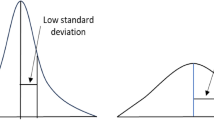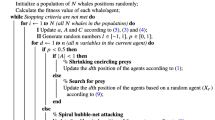Abstract
This paper introduces a new technique in the investigation of object classification and illustrates the potential use of this technique for the analysis of a range of biological data, using avian morphometric data as an example. The nascent variable precision rough sets (VPRS) model is introduced and compared with the decision tree method ID3 (through a ‘leave n out’ approach), using the same dataset of morphometric measures of European barn swallows (Hirundo rustica) and assessing the accuracy of gender classification based on these measures. The results demonstrate that the VPRS model, allied with the use of a modern method of discretization of data, is comparable with the more traditional non-parametric ID3 decision tree method. We show that, particularly in small samples, the VPRS model can improve classification and to a lesser extent prediction aspects over ID3. Furthermore, through the ‘leave n out’ approach, some indication can be produced of the relative importance of the different morphometric measures used in this problem. In this case we suggest that VPRS has advantages over ID3, as it intelligently uses more of the morphometric data available for the data classification, whilst placing less emphasis on variables with low reliability. In biological terms, the results suggest that the gender of swallows can be determined with reasonable accuracy from morphometric data and highlight the most important variables in this process. We suggest that both analysis techniques are potentially useful for the analysis of a range of different types of biological datasets, and that VPRS in particular has potential for application to a range of biological circumstances.
Similar content being viewed by others
References
An, A., N. Shan, C. Chan, N. Cercone and W. Ziarko (1996). Discovering rules for water demand prediction: an enhanced rough-set approach. Eng. Appll. Artif. Intell. 9, 645–653.
Beynon, M. (2000). An investigation of β-reduct selection within the variable precision rough sets model, in Proceedings of the Second International Conference on Rough Sets and Current Trends in Computing—Lecture Notes in Artificial Intelligence Series, RSCTC 2000, Banff, Canada, W. Ziarko and Y. Yao (Eds), Springer, pp. 82–90.
Beynon, M. (2001). Reducts within the variable precision rough sets model: a further investigation. Eur. J. Oper. Res. 134, 134–147.
Beynon, M. J. (2002). An investigation of β-reduct selection within the variable precision rough sets model, in Proceedings of the Third International Conference on Rough Sets and Current Trends in Computing—Lecture Notes in Artificial Intelligence Series, RSCTC 2002, Malvern, PA, USA, J. J. Alpigini, J. F. Peters, A. Skowron and N. Zhong (Eds), Springer, pp. 530–537.
Beynon, M., B. Curry and P. Morgan (2000). Classification and rule induction using rough set theory. Expert Syst. 17, 136–148.
Beynon, M. and M. Peel (2001). Variable precision rough set theory and data discrimination: an application to corporate failure prediction. OMEGA 29, 561–576.
Browne, C., I. Duntsch and G. Gediga (1998). IRIS revisited: a comparison of discriminant and enhanced rough set data analysis, in Rough Sets in Knowledge Discovery 2: Applications, Case Studies and Software Systems, L. Polkowski and A. Skowron (Eds), New York: Physica-Verlag, pp. 345–368.
Buchanan, K. L. and M. R. Evans (2000). The effect of tail streamer length on aerodynamic performance in the barn swallow. Behav. Ecol. 11, 228–238.
Chmielewski, M. and J. Grzymala-Busse (1996). Global discretization of continuous attributes as preprocessing for machine learning. Int. J. Approximate Reasoning 15, 319–331.
Cuthill, I. C., A. T. D. Bennett, J. C. Partridge and E. J. Maier (1999). Plumage reflectance and the objective assessment of avian sexual dichromatism. Am. Nat. 153, 183–200.
Dimitras, A., R. Slowinski, R. Susmaga and C. Zopounidis (1999). Business failure using rough sets. Eur. J. Oper. Res. 114, 263–280.
Dougherty, J., R. Kohavi and M. Sahami (1995). Supervised and unsupervised discretization of continuous features, in Machine Learning: Proceedings of the Twelth International Conference, Tahoe City, San Fransisco: Kaufmann, pp. 194–202.
Fayyad, U. M. and K. B. Irani (1992). On the handling of continuous-valued attributes in decision tree generation. Mach. Learn. 8, 87–102.
Fayyad, U. M. and K. B. Irani (1993). Multi-interval discretization of continuous-valued attributes for classification learning, in Proceedings of the 13th International Joint Conference on Artificial Intelligence, Morgan Kaufman, pp. 1022–1027.
Grzymala-Busse, J. W. and X. Zou (1998). Classification strategies using certain and possible rules, in Rough Sets and Current Trends in Computing Systems, First International Conference RSCTC’98, L. Polkowski and A. Skowron (Eds), Heidelberg: Springer Verlag, pp. 37–44.
Jelonek, J., K. Krawiec and R. Slowinski (1995). Rough set reduction of attributes and their domains for neural networks. Comput. Intell. 11, 339–347.
Kane, G., F. Richardson and N. Meade (1998). Rank transformation and the prediction of corporate failure. Contemp. Acc. Res. 15, 145–166.
Kim, H. and G. J. Koehler (1995). Theory and practice of decision tree induction. OMEGA 23, 637–652.
Krusinska, E., R. Slowinski and J. Stefanowski (1992). Discriminant versus rough set approach to vague data analysis. Appl. Stoch. Model. D. A. 8, 43–56.
Lessels, C. M. and B. T. Boag (1987). Unrepeatable repeatabilities: a common mistake. Auk 104, 116–121.
Mak, B. and T. Munakata (2002). Rule extraction from expert heuritics: a comparative study of rough sets with neural networks and ID3. Eur. J. Oper. Res. 136, 212–229.
Møller, A. P. (1994). Sexual Selection and the Barn Swallow, Oxford: Oxford University Press.
Møller, A. P. and J. P. Swaddle (1997). Asymmetry, Developmental Stability and Evolution, Oxford: Oxford University Press.
Nguyen, H. S. and S. H. Nguyen (1998). Discretization methods in data mining, in A Rough Sets in Knowledge Discovery 1: Methodology and Applications, New York: Physica-Verlag, pp. 451–482.
Niblett, T. (1987). Constructing decision tress in noisy domains, in Proceedings of the Second European Working Session on Learning, Bled: Sigma Press, pp. 67–78.
Pal, S. K. and A. Skowron (1999). Rough Fuzzy Hybridization: A New Trend In Decision-Making, Singapore: Springer.
Pawlak, Z. (1982). Rough Sets. Int. J. Inf. Comput. Sci. 11, 341–356.
Pawlak, Z. (1991). Rough Sets—Theoretical Aspects of Reasoning About Data, London: Kluwer Academic Publishers.
Pomorski, D. and P. B. Perchie (2001). Inductive learning of decision trees: application to fault isolation of an induction motor. Eng. Appl. Artif. Intell. 14, 155–166.
Quinlan, R. (1986). Induction of decision trees. Mach. Learn. 1, 86–106.
Ren, B. (2002). Novel atom-type AI indices for QSPR studies of alcohols. Comput. Chem. 26, 223–235.
Slowinski, R. and J. Stefanowski (1992). RoughDAS and RoughClass software implementations of the rough sets approach, in Intelligent Decision Support, Applications and Advances of the Rough Sets Theory, R. Slowinski (Ed.), London: Kluwer Academic Publishers, pp. 445–460.
Slowinski, R., C. Zopounidis and A. I. Dimitras (1997). Prediction of company acquisition in Greece by means of the rough set approach. Eur. J. Oper. Res. 100, 1–15.
Smith, H. G. and R. Montgomerie (1991). Sexual selection and the tail ornaments of North American barn swallows. Behav. Ecol. Sociobiol. 28, 195–201.
Stefanowski, J. (1992). Classification support based on the rough set theory. Proc. IIASA Workshop on User-Oriented Methodology and Techniques of Decision Analysis and Support, Serock, September 9–13, 1991.
Svensson, L. (1992). Identification Guide to European Passerines, Stockholm: Svensson.
Szczuka, M. S. (1998). Rough sets and artificial neural networks, in Rough Sets in Knowledge Discovery 2: Applications, Case Studies and Software Systems, L. Polkowski and A. Skowron (Eds), New York: Physica-Verlag, pp. 449–470.
Vanfraneker, J. A. and C. J. F. Terbraak (1993). A generalized discriminant for sexing fulmarine petrels from external measurements. Auk 110, 492–502.
Weiss, S. M and C. A. Kulikowski (1991). Computer Systems That Learn, SanMateo, CA: Morgan Kaufman.
Zavalaga, C. B. and R. Paredes (1997). Sex determination of adult Humboldt Penguins using morphometric characters. J. Field Ornith. 68, 102–112.
Ziarko, W. (1993a). Variable precision rough sets model. J. Comput. Syst. Sci. 46, 39–59.
Ziarko, W. (1993b). Analysis of uncertain information in the framework of variable precision rough sets. Found. Comput. Decis. Sci. 18, 381–396.
Ziarko, W. and Y. Yao (2001). Rough Sets and Current Trends in Computing, Second International Conference RSCTC’2000, Heidelberg: Springer Verlag.
Author information
Authors and Affiliations
Corresponding author
Rights and permissions
About this article
Cite this article
Beynon, M.J., Buchanan, K.L. An illustration of variable precision rough set theory: The gender classification of the European barn swallow (Hirundo rustica). Bull. Math. Biol. 65, 835–858 (2003). https://doi.org/10.1016/S0092-8240(03)00044-2
Received:
Accepted:
Issue Date:
DOI: https://doi.org/10.1016/S0092-8240(03)00044-2




